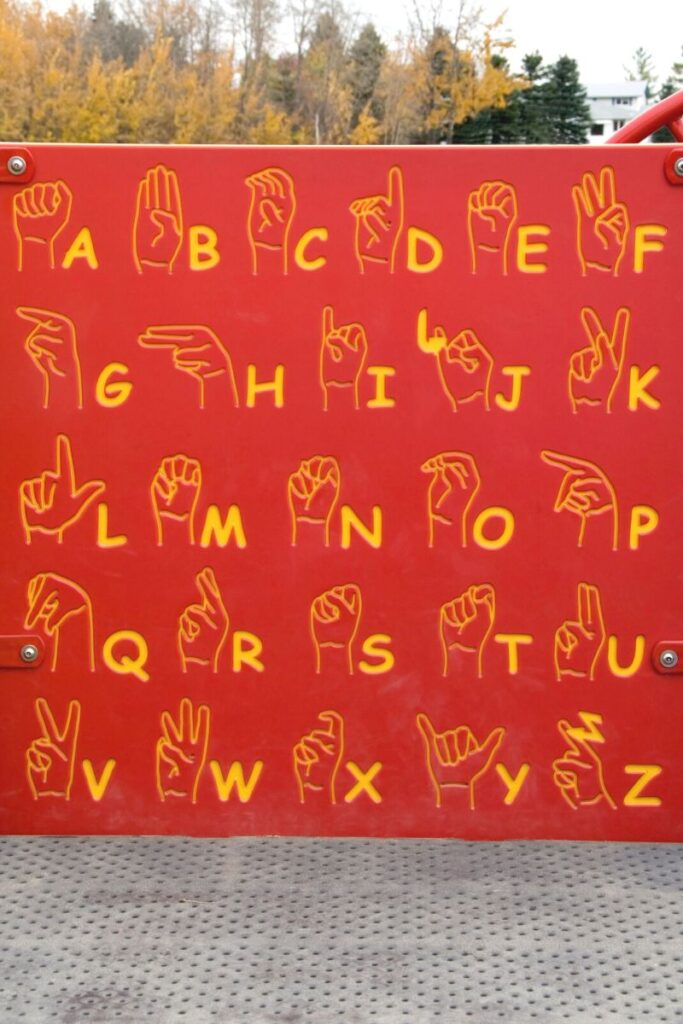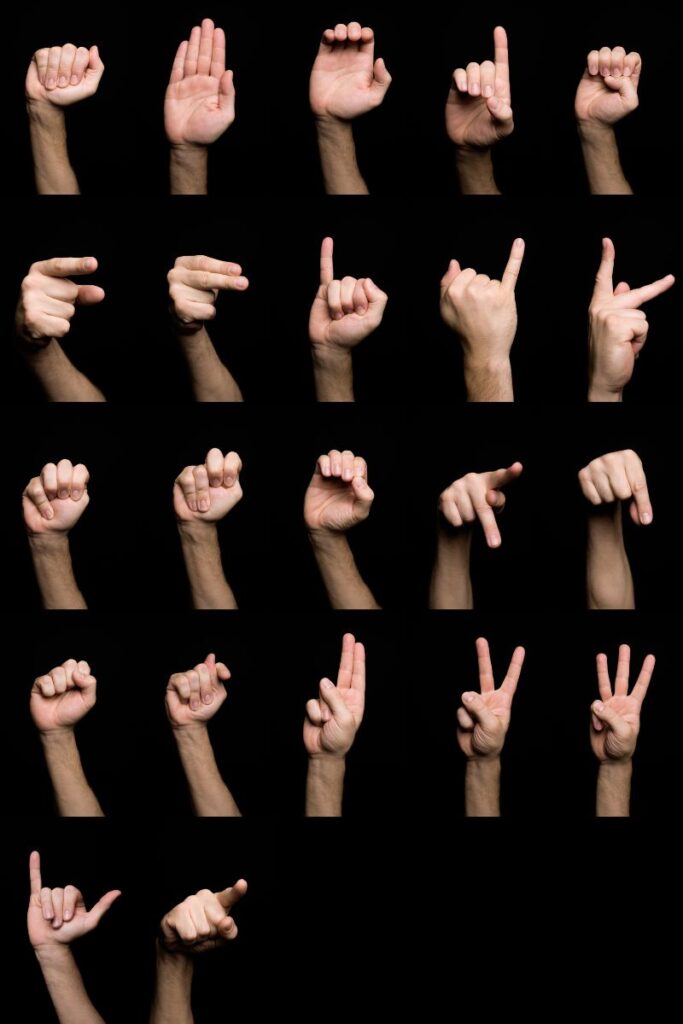Sign language is so much more than speaking with your hands. These facts about sign language might give you a helping hand in understanding it!

Lend us your eyes and ears to learn some facts about sign language! It might not seem it if you don’t speak it, but sign language is a major language spoken by millions of people all around the world.
In fact, there are around 300 versions of sign language, each one slightly different! Not all of them are widely spoken, however.
In America, about 2 million people rely on American Sign Language (ASL) to communicate with their friends and family.
It’s easy to forget sign language as an actual language. People learn to sign in the same way they learn to speak. Also, different parts of your brain are used to speaking which is pretty cool.

Speaking sign language is much more than making motions with your hands. Did you know that sign language has grammar rules? If you break these rules, listeners might not understand what you’re saying.
Just like in many languages, there are gender rules in sign language too. You sign feminine and masculine words differently.
Not only are signs different in different countries, but you even use your hands in unique ways. In America, you can sign the alphabet with one hand, but you need both hand in Britain and Germany.
So, stay tuned for some fun facts about sign language. Maybe by the end of this article you’ll want to try signing yourself!

20 Fun Facts About Sign Language
1. American Sign Language isn’t the only one
American Sign Language (ASL) is the most common version spoken in America. But just like there are different languages spoken around the world, there are different versions of sign language.
Even though ASL is the most popular sign language, it’s not universal. That means, if you speak ASL, it doesn’t mean people will understand you in other English speaking countries like Australia and the UK.
2. All English sign languages aren’t the same
English speakers around the world generally understand each other. Dialects and accents differ, but the words are basically the same. However, this is not true with sign language.
British Sign Language is very different from American Sign Language. In fact, ASL has more in common with French Sign Language than the British version.

3. It’s about more than just hands
Sign language was invented so people that are deaf could communicate without spoken words. While this language mostly relies on hand gestures, there are other factors to truly understand it.
Just like tone and rhythm add meaning to spoken words, facial expressions are essential when speaking with sign language. So, listeners don’t just watch the symbols, they also watch the speaker’s face and mouth.
4. It’s so easy a monkey can do it
Well, maybe sign language isn’t that easy. It is, after all, a complex language. However, both monkeys and babies have been able to learn simple sign language.
Children learn sign language in the same general pattern they learn to speak. First, babies will start with simple signs or incorrect symbols that represent a word to them. Then, as they get older, they refine their sign language and the motions become more correct.
5. Sign language is quite common
In the world, more than 70 million people use a version of sign language as their primary means of communication. And more than 150 million people throughout the world use sign language to communicate with friends or family members that are hearing impaired.

6. It’s fairly popular in America
In America alone, there are just under 1 million people that are deaf or hearing impaired, or about 3.6% of the population.
It’s thought that up to 2 million people speak American Sign Language. ASL is the fifth most common language spoken in America behind English, Spanish, Italian, German, and French. How about that as one of the top ASL facts for you there!
7. Sign language has grammar rules
Grammar rules for sign language have to do with body positioning. How the speaker forms their eyebrows and eyes along with where they hold their hands is incredibly important when speaking sign language.
If you use your body incorrectly, you might confuse the listener as to what you’re actually saying.
8. It is essential
The American Speech-Language Hearing Association, or ASHA, found that hearing loss is the third most common chronic health condition that older generations face. When humans age, their ability to hear decreases. Sign language is an answer to hearing loss.
Older Americans should take this fact about sign language to heart and think about learning it! Hearing loss rarely has anything to do with the physical ear, it’s just something that happens as we get older!

9. Brain injuries affect the ability to sign
Just like an injury to one’s brain, either from trauma or stroke, can affect their ability to speak words, it can also affect their ability to speak in sign language. Brain injury sufferers must often learn to sign again through therapy.
10. Signs are feminine or masculine
Just like in many spoken languages, there are different signs to refer to gender. In American Sign Language, speakers sign words and terms referring to women near the speaker’s jaw. However, when one speaks about a man, one makes the signs near their forehead.
11. There are lots of different types of sign languages
In fact, there are more than 300 different versions of sign language in the world, but only 130 are internationally recognized.
The most common variations are American, French, British, Italian, Chinese, Japanese, German, and Korean. These versions developed similarly to spoken languages with their own phrases and dialects.

12. Learning sign language is good for your brain
It’s no secret that learning a second language is beneficial to brain function. Science tells us speaking more than one language improves memory, increases problem-solving skills and critical thinking, enhances concentration, and increases one’s ability to multitask.
It’s also shown to decrease the chances of dementia and Alzheimer’s later in life. This sign language fact might encourage you to learn ASL!
13. It’s part of baseball
If you have ever watched or played baseball, you have likely noticed that coaches and players communicate on the field with signs. This practice is because of a deaf player on the Chicago White Sox, William “Dummy” Hoy.
Since he couldn’t hear the umpire’s calls, Hoy and his coach came up with a series of signals to pass the calls on. Over time, this caught on with other players and teams. Now, teams across all sports utilize sign language to secretly communicate!
14. The alphabet is different
Depending on which sign language you are speaking, the actual alphabet is quite different. For example, speakers only use one hand to show letters in ASL. However, you would use both hands to say the alphabet if you were in Germany or Britain.

15. Names have a sign
Rather than spell out a name, people have a sign that represents their name. When you meet a new person who speaks sign language, it is common practice to exchange how to sign one’s name as an introduction.
16. There’s no round of applause
Since people who are deaf can’t hear, clapping for a performance or event doesn’t make sense. Instead, the appropriate way to cheer in sign language is to wiggle or shake one’s hands in the air. This action shows someone the listener is happy and appreciated the show.
17. Hold my calls
Because speaking on the phone requires audible words, people who are hearing impaired utilize a teletypewriter, or a TTY. This machine allows them to type a message and then send it to whoever they are communicating with. Then, the TTY will flash a light to signal a message has been sent back.

18. Sign language brings the community together
Rather than being deaf as a handicap, people in the deaf community often see it as an asset. Sign language is what binds them together.
In fact, many people refuse implants and hearing aids because they fear it will separate them from the hearing-impaired community.
19. ASL is considered a foreign language
Because sign language has its own set of grammar rules, it is considered a foreign language. That is why learning ASL has the same benefits as learning another language, like Spanish or Chinese.
20. There is an ASL college
Gallaudet University in Washington DC offers most of its classes in American Sign Language. Thomas Hopkins Gallaudet, a minister from Connecticut who devoted his life to helping the deaf be able to communicate, founded the college in 1864.
He traveled to France where he studied a well-known school for the deaf. Eventually, he, along with Laurent Clerc, founded Gallaudet University to serve the hearing-impaired community.
Who wants more fun facts?

If you’re looking for some recommendations, these are a few of our favorite fact books to buy. We use these when planning fun trivia nights with family and friends!
These facts about sign language might be new to you, but an entire population relies on them. Next time you see someone speaking sign language, you might have a new appreciation for them!
If you have any sign language facts that we’ve missed out on, let us know in the comments below and we’ll add them to this article!



